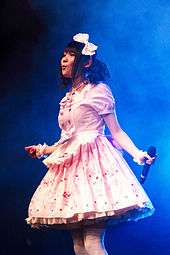Frock


Frock has been used since Middle English as the name for an article of clothing for men and women. In Standard and World English the word is used as an alternative term for a girl's or woman's dress. In Australia it is frequently used this way, with the phrase "to frock up" meaning to wear a formal dress or gown for a special occasion.[1]
History
Originally, a frock was a loose, long garment with wide, full sleeves, such as the habit of a monk or priest, commonly belted. (This is the origin of the modern term defrock or unfrock, meaning "to eject from the priesthood".)
The term has been continually applied to various types of clothing, generally denoting a loosely fitted garment:
- From the 16th century to the early 20th century, frock was applied to a woman's dress or gown, in the fashion of the day, often indicating an unfitted, comfortable garment for wear in the house, or (later) a light overdress worn with a slip or underdress.
- From the 17th century on, a frock is a thigh- or full-length loose outer garment worn by shepherds, workmen, and farm workers in Britain, generally of heavy linen with a broad flat collar, now usually called a smock-frock. In some areas, this traditional frock buttons up the front in the manner of a coat, while in others it is a pullover style.
- In the 18th century in Britain and America, a frock was an unfitted men's coat for hunting or other country pursuits, with a broad, flat collar, derived from the traditional working-class frock. Late in the 18th century it came to be made with a cutaway front without a waist seam and this may have evolved into the standard dress coat with horizontally cutaway fronts worn for daytime wear by the early 19th century and from which the modern tail coat for white tie is derived. The great coat may similarly be historically derived from the frock as it similarly is single breasted, with a high and broad collar, waist pockets, and also lacked a waist seam early in its history as can be seen in an example in the Victoria and Albert Museum, London.
The precise historical evolution of the frock after the second half of the 18th century is obscure, however it is likely that the frock was gradually supplanted by the frock coat in the early 19th century, eventually being relegated to evening dress. The frock coat in turn became cut away into the modern coat, giving us the two modern coats with tails.
- Frock is also a woman’s or girl’s dress.[2][3]
- Frock (especially in the phrase "short frock") can be a child's dress or light overdress.
- A frock is a dense knitted overgarment worn by sailors and fishermen, as guernsey frock, jersey frock (now usually simply guernsey and jersey).
- The name "oil frock" has been used for a type of sailor's oilskin.
Related terms
A frock coat is a men's coat style of the 19th century, characterized by full skirts reaching to the lower thigh or knee. Despite the similarity in the name, the frock coat should be regarded as being a distinct garment quite separate from the frock. In the French language the frock coat is called 'une redingote' (from English "riding coat"), and so unlike the English language implies no immediate relationship to the frock which is called 'une fraque'. Indeed, the modern French word for a tail coat is "une frac" which better betrays the historical relationship between the tail coat and the frock. In construction the frock coat could scarcely be more different from the frock for unlike the latter it is usually double breasted, lacks any pockets, lacks a high collar, has V-shaped lapels, is closely fitted and is constructed with a waist seam.
A frock motor is a hub motor frequently fitted to electric bicycles. Unlike belt or chain driven motors which can pose a hazardous entanglement risk to those wearing long or loose garments, the hub motor is laced into the center of the bicycle's wheel. With no fast moving parts near the rider's legs it poses little threat to those wearing frock-like garments. Frock motors are either internally geared or direct drive and come in various sizes depending on their power output. They are the most common type of electric bicycle motor and are fitted to millions of bicycles throughout China and around the world.
See also
References
- ↑ "Macquarie Dictionary". Retrieved 6 May 2013. (subscription required)
- ↑ Carefree Clothes for Girls: 20 Patterns for Outdoor Frocks, Playdate Dresses, and More -book by Junko Okawa (Shambhala Publications, 2009)
- ↑ Oxford Dictionary meaning of Frock
- Oxford English Dictionary
- Picken, Mary Brooks: The Fashion Dictionary, Funk and Wagnalls, 1957.
- Walker, George: The Tailor's Masterpiece: All Kinds of Coats, 1838 revised edition, reprinted by R.L. Shep, 2001. ISBN 0-914046-28-4.
- Waugh, Norah: The Cut of Men's Clothes 1600–1900, Routledge, 1964. ISBN 0-87830-025-2.
External links
-
 Chisholm, Hugh, ed. (1911). "Frock". Encyclopædia Britannica. 11 (11th ed.). Cambridge University Press. p. 238.
Chisholm, Hugh, ed. (1911). "Frock". Encyclopædia Britannica. 11 (11th ed.). Cambridge University Press. p. 238. - ApparelSearch glossary of textile and apparel terms